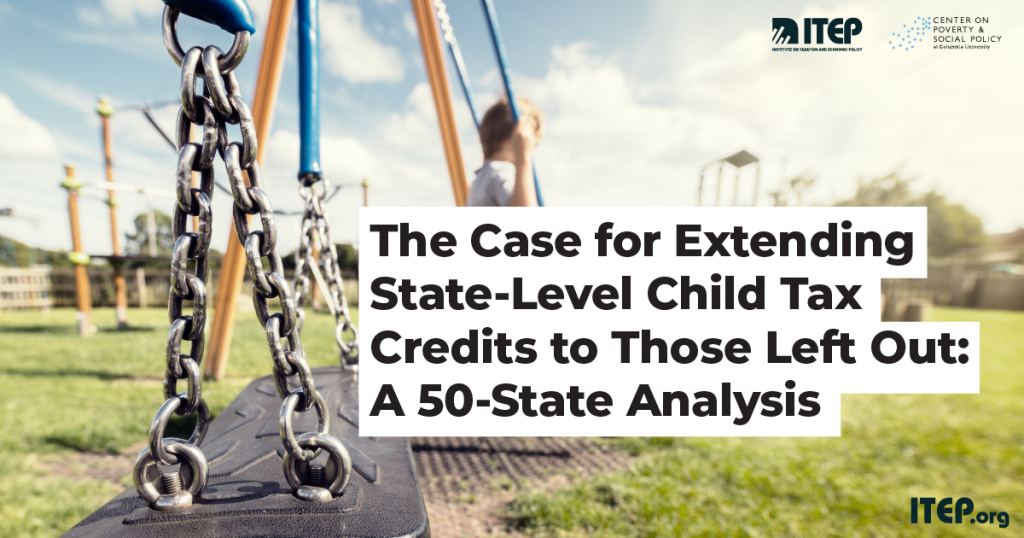Expanding the Child Tax Credit (CTC) at the state level could lift millions of children out of poverty and help families who benefited little or not at all from the 2017 federal expansion of the CTC, according to a 50-state report released today by the Institute on Taxation and Economic Policy and the Center on Poverty and Social Policy at Columbia University.
The report, The Case for Extending State-Level Child Tax Credits to Those Left Out: A 50-State Analysis, outlines two bold options for creating state-level CTCs. The first would reduce child poverty by at least 15 percent in all but four states. The second, more ambitious option would reduce child poverty by at least 25 percent in all states and up to 45 percent in more than half of states.
“Child poverty has declined substantially since the 1960s, but at 15.6 percent we still have room for improvement,” said Christopher Wimer, co-director at the Center on Poverty and Social Policy at Columbia University. “We know that life outcomes are better for children whose families have the resources to help them thrive. That alone is reason enough to look at bold solutions that will reduce the number of children living in poverty even further.”
The 2017 Tax Cuts and Jobs Act expanded the federal CTC, increasing the value of the credit from $1,000 to $2,000. But with a requirement for earnings and a $1,400 cap on refundability (it also excludes families who owe less than $1,400 in income tax), more than 24 million children are either not eligible at all for the credit or only receive a partial credit. Some federal policymakers have introduced promising legislation to address this gap, but state lawmakers do not need to wait on Congress to take steps to drastically reduce child poverty.
The report outlines two bold proposals and highlights the effect each would have on child poverty rates in all states and the District of Columbia. Not only would the proposals reduce overall child poverty, they also would extend the credit to more Black and Latinx children. The current federal CTC is doing a better job of lifting white children out of poverty than other children; these proposals would address that disparity. Furthermore, expanding the child tax credit would help remedy the regressive structure of state tax systems.
Options for expanding state CTCs described in the report are:
- Bring every qualifying child to the full $2,000 credit, or
- bring qualifying children six and under to a $3,600 credit and older children to $3,000.
The first option proposes a state CTC designed for working families (except those whose earnings are too high to receive the federal credit) who are not at all or only partially eligible for the $2,000 per child federal CTC. This proposal would essentially fill in gaps left by the federal credit. For example, families who are receiving a partial federal credit of $1,400 would receive $600 in state CTC under this proposal. The policy would reduce child poverty in all but four states by more than 15 percent, and it would reduce child poverty in 18 states by more than 25 percent. State-by-state data on how this proposal could reduce child poverty is available here.
The second proposal is far more ambitious and would be far more effective at reducing child poverty. It not only closes gaps in the current federal law, but it builds on the credit. The proposal is essentially equivalent to the federally proposed American Family Act. By boosting the credit to a maximum of $3,600 and expanding eligibility, more families would benefit from this plan. The report cites a hypothetical example of a family of four earning $50,000 with two children ages five and eight. The family receives $4,000 in credits under the current federal law. Under a state expansion, the family would receive an additional $1,600. State-by-state data on how this proposal would reduce child poverty is available here. In addition, the report provides details on the total number of children and adults benefiting under each proposal, beyond poverty reduction.
Of course these proposals require resources. The report outlines costs for both proposals in each state in addition to showing the effect on poverty reduction. For example, Oregon would experience one of the most dramatic reductions (35 percent) in child poverty under the first proposal at a cost of $334 million. In total, 544,000 people would benefit, including 317,000 children. The more ambitious proposal would reduce child poverty in Oregon by 55 percent and benefit 1.35 million people, including 740,000 children. This plan would cost the state $1.1 billion.
“The nation is currently having an important conversation about income inequality,” said Aidan Davis, a senior policy analyst at ITEP and an author of the report. “It’s clear that reducing income inequality requires multi-dimensional, bold solutions at both the federal and state levels. Enacting and expanding state child tax credits should be part of the solution. It’s something that will have an immediate and lasting effect for children and their families.”



